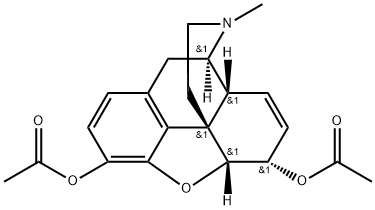CHEMICAL AND PHYSICAL PROPERTIES
| Color/Form | Orthorhombic plates, tablets from ethyl acetate |
|---|---|
| Odor | Odorless |
| Taste | Bitter |
| Boiling Point | 272-274 °C at 1.20E+01 mm Hg |
| Melting Point | 173 °C |
| Solubility | 600 mg/L (at 25 °C) |
| Density | 1.56 g/cu m at 25 °C |
| Vapor Pressure | 7.59X10-10 mm Hg at 25 °C |
| LogP | 1.58 |
| Stability/Shelf Life | Stable under recommended storage conditions. |
| Optical Rotation | Needles, mp 242 °C; Specific optical rotation: -197 deg at 20 °C/D (c= 0.896) /Diacetylmorphine methyl iodide/ |
| Decomposition | ... Decomposes by boiling with water. |
| Dissociation Constants | 7.96 |
| Collision Cross Section | 185.7 Ų [M+H]+ [CCS Type: DT, Method: single field calibrated] |
| Other Experimental Properties | Fine crystals; mp 243-244 °C; specific optical rotation: -156 deg at 24 °C/D (c = 1.044); soluble in 2 parts water, 11 parts alcohol; insoluble in ether /Diacetylmorphine hydrochloride monohydrate/ |
SAFETY INFORMATION
| Signal word | Danger |
|---|---|
| Pictogram(s) |
 Flame Flammables GHS02  Skull and Crossbones Acute Toxicity GHS06 |
| GHS Hazard Statements |
H225:Flammable liquids H319:Serious eye damage/eye irritation H331:Acute toxicity,inhalation |
| Precautionary Statement Codes |
P210:Keep away from heat/sparks/open flames/hot surfaces. — No smoking. P261:Avoid breathing dust/fume/gas/mist/vapours/spray. P337+P313:IF eye irritation persists: Get medical advice/attention. P403+P233:Store in a well-ventilated place. Keep container tightly closed. |
COMPUTED DESCRIPTORS
| Molecular Weight | 369.4 g/mol |
|---|---|
| XLogP3 | 1.5 |
| Hydrogen Bond Donor Count | 0 |
| Hydrogen Bond Acceptor Count | 6 |
| Rotatable Bond Count | 4 |
| Exact Mass | 369.15762283 g/mol |
| Monoisotopic Mass | 369.15762283 g/mol |
| Topological Polar Surface Area | 65.1 Ų |
| Heavy Atom Count | 27 |
| Formal Charge | 0 |
| Complexity | 692 |
| Isotope Atom Count | 0 |
| Defined Atom Stereocenter Count | 5 |
| Undefined Atom Stereocenter Count | 0 |
| Defined Bond Stereocenter Count | 0 |
| Undefined Bond Stereocenter Count | 0 |
| Covalently-Bonded Unit Count | 1 |
| Compound Is Canonicalized | Yes |
PRODUCT INTRODUCTION
description
Heroin is a morphinane alkaloid that is morphine bearing two acetyl substituents on the O-3 and O-6 positions. As with other opioids, heroin is used as both an analgesic and a recreational drug. Frequent and regular administration is associated with tolerance and physical dependence, which may develop into addiction. Its use includes treatment for acute pain, such as in severe physical trauma, myocardial infarction, post-surgical pain, and chronic pain, including end-stage cancer and other terminal illnesses. It has a role as an opioid analgesic, a mu-opioid receptor agonist and a prodrug. It is functionally related to a morphine.

